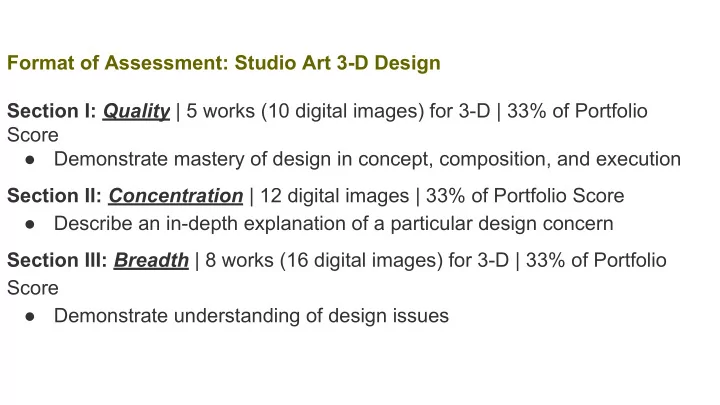

Format of Assessment: Studio Art 3-D Design Section I: Quality | 5 works (10 digital images) for 3-D | 33% of Portfolio Score ● Demonstrate mastery of design in concept, composition, and execution Section II: Concentration | 12 digital images | 33% of Portfolio Score ● Describe an in-depth explanation of a particular design concern Section III: Breadth | 8 works (16 digital images) for 3-D | 33% of Portfolio Score ● Demonstrate understanding of design issues
Concentration Marianna Garvey
Central Idea - Basic The central idea of my concentration is the communication of 3D design principles within a set of parameters; using only breath freshening agents (Altoids, Tic Tacs), paper, and a limited color palette. The central challenge was to create twelve related but separate works which engage the space they occupy as stand alone pieces, and together as a whole.
Central Idea - Way Better! Artists utilize the elements and principles of art to communicate with an audience on the most basic level of understanding and connection--through visual context. However, the vastness of this mode of communication is infinite. In order to effectively impart meaning and engage the viewer, artists must set and follow rules. Working within a set of parameters, I created small scale installation pieces utilizing visual elements (line, volume, light, color, form, plane, texture, and mass) to explore the basic tenants of 3D design principles: unity/variety, balance, emphasis, contrast, rhythm, scale, and space. As my idea evolved I found myself challenged to engage the same format (an altoid tin and paper) in myriad ways. It was only through tedium and failed attempts in which trial and error gave way to solutions and inspiration.
Intent and Exploration Each of these works employs only the use of the aforementioned materials and demonstrates use of the art elements to communicate and investigate 3D design principles. For example, Work #1 employs alternating positive and negative space to create a sense of rhythm, while Work #2 utilizes the shape in the same way. In Work #3 line is physically created by the cut edge and also implied by the shadow formed from the slight angle of the paper. And in Work #12, the cut paper is manipulated to show volume and movement.
Altoids tin, cut paper 3.5” x 3.0” x 2.5”
Altoids tin, cut paper 3.5” x 3.0” x 2.5”
Altoids tin, cut paper 3.5” x 3.0” x 2.5” Side view
Altoids tin, cut paper, floss 3.5” x 3.0” x 2.5”
Altoids tin, cut paper 3.5” x 3.0” x 2.5”
Altoids tin, cut paper 3.5” x 3.0” x 2.5”
Altoids tin, cut paper 3.5” x 3.0” x 2.5”
Altoids tin, cut paper 3.5” x 3.0” x 2.5”
Altoids tin, cut paper 3.5” x 3.0” x 2.5”
Altoids tin, Tic Tac, paper, guoache 3.5” x 3.0” x 2.5”
Altoids tin, cut paper, guoache 3.5” x 3.0” x 2.5”
Altoids tin, cut paper 3.5” x 3.0” x 2.5”
Altoids tin, cut paper 3.5” x 3.0” x 2.5”
Recommend
More recommend